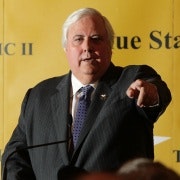When double-entry accounting gets ugly
August is a critical month in the business calendar, with most listed companies signing off and publishing their full-year or half-year accounts. But when you're poring over them this time, think of Venice and not Monty Python. Accounting may be tedious but it's hardly boring. Just ask the former directors of Centro and ABC Learning.
Why Venice? Because, as well as an enchanting spot to inhale history, culture and art, it was the home of modern accounting which, it turns out, was central to the Venetians' success as such powerful traders during the Renaissance, when their Rialto was the swaggering Wall Street of Europe. It was there in 1494 that Fra Luca Bartolomeo de Pacioli published his landmark treatise on double-entry accounting, the system we still use today.
I learned this recently from Jane Gleeson-White's book, Double Entry, which Jane and I will be chatting about at the Byron Bay Writers' Festival this weekend, together with respected business and cricket writer, Gideon Haigh, who wrote The Office (not the TV comedy series, but the masterful and engaging history of the place we spend years of our lives).
But back to Venice. The Italians took double-entry accounting all over the world, just as they did espresso, though it seems some Americans have as much trouble with their accounts as they do with what they call coffee.
It's not just Americans. The French have embraced double-entry accounting so much they take the "double” to extremes, and I don't mean DSK, the philandering politician. France insists that companies have two audit firms, not one, to sign off on their accounts. And, there are advocates urging that system onto the wider Europe, as if this will fix their malaise.
But why stop at two? Surely three would be even better, and safer. Well, think again. "The tragedy of the three auditors”, the tale of failed childcare group, ABC Learning, tosses that idea right out of the sandbox.
For years, ABC Learning's accounts were audited by a reputable mid-sized Australian firm, Pitcher Partners. As the childcare group expanded into the US, it became apparent to Pitchers and to the ABC Learning board – to both their credits – that the company might benefit from "up scaling” the audit to an international firm. The board conducted a tender and eventually hired Ernst & Young, first, sensibly, to shadow Pitchers for the 2007 year-end audit and then to take over for the next half-year.
In shadowing Pitchers, Ernst & Young apparently took no significant issue with the basis on which the year-end accounts were presented. But when the new audit firm was itself signing off on the following half-year's accounts, it took a very different view of how certain receipts should be categorised, thereby casting an ominous dark cloud over the group's profitability, indeed its viability.
Pitchers vigorously defended its past categorisation. As you might expect, the company's board encouraged Ernst & Young and Pitchers to engage in a vigorous debate with the aim of resolving the difference of opinion, but both firms stuck to their green pencils.
The ABC Learning board was in a quandary, having relied on Pitchers for years and having themselves brought in Ernst & Young, so they asked yet another audit firm, KPMG, to break the deadlock and give it a fresh and independent opinion.
The next astonishing thing, given the gulf between the two other firms let alone the dire consequences for stakeholders, was that KPMG apparently concluded that the accounting standards justified the two opposing positions.
If that was an eye-popper for the ABC Learning board, and the other stakeholders, it gets even more fascinating to know that the corporate regulator may have agreed with them. Both Gleeson-White and the Sydney Morning Herald's Colin Kruger reported that the Australian Securities and Investments Commission was asked to examine this question in 2006, over a year earlier.
This was when an unnamed complainant wrote to ASIC as follows: "It's suggested that the methods of financial reporting being employed here are designed to artificially create apparent shareholder value, when, in fact, that shareholder value associated with the child-care licences (91 per cent of net assets) is based entirely on the future net cash flows of the company, which may or may not be realised. It's also suggested that this may be misleading to potential investors in the company.”
According to these two writers, an ASIC official replied to the complainant in September 2006 – well before ABC Learning collapsed – stating the regulator had "made a number of inquiries into the issues [raised]… However, after carefully considering the results of these inquiries, ASIC will not be taking any further action".
So there was a board of a listed company, for years relying on auditors who, according to another prestigious international firm, had at least an arguable case plus, it seems, ASIC held a similar view.
Yet, the market was not so forgiving and, understandably, reacted badly when it was told that ABC might not know its one, two, threes.
The Italians have a lot to take credit for, but double-entry accounting can also be a two-edged sword.
John M Green is a leading company director, commentator and novelist. His latest thriller, about a US presidential election, Born to Run, is now in paperback and ebook. Click here for a free chapter and book trailer.
















